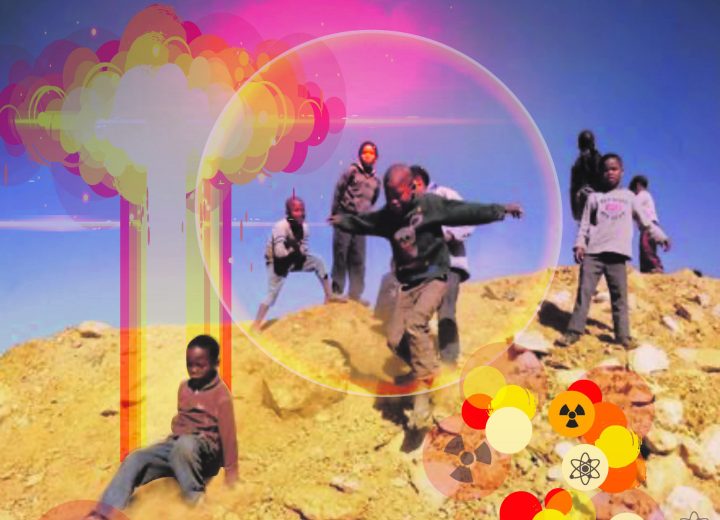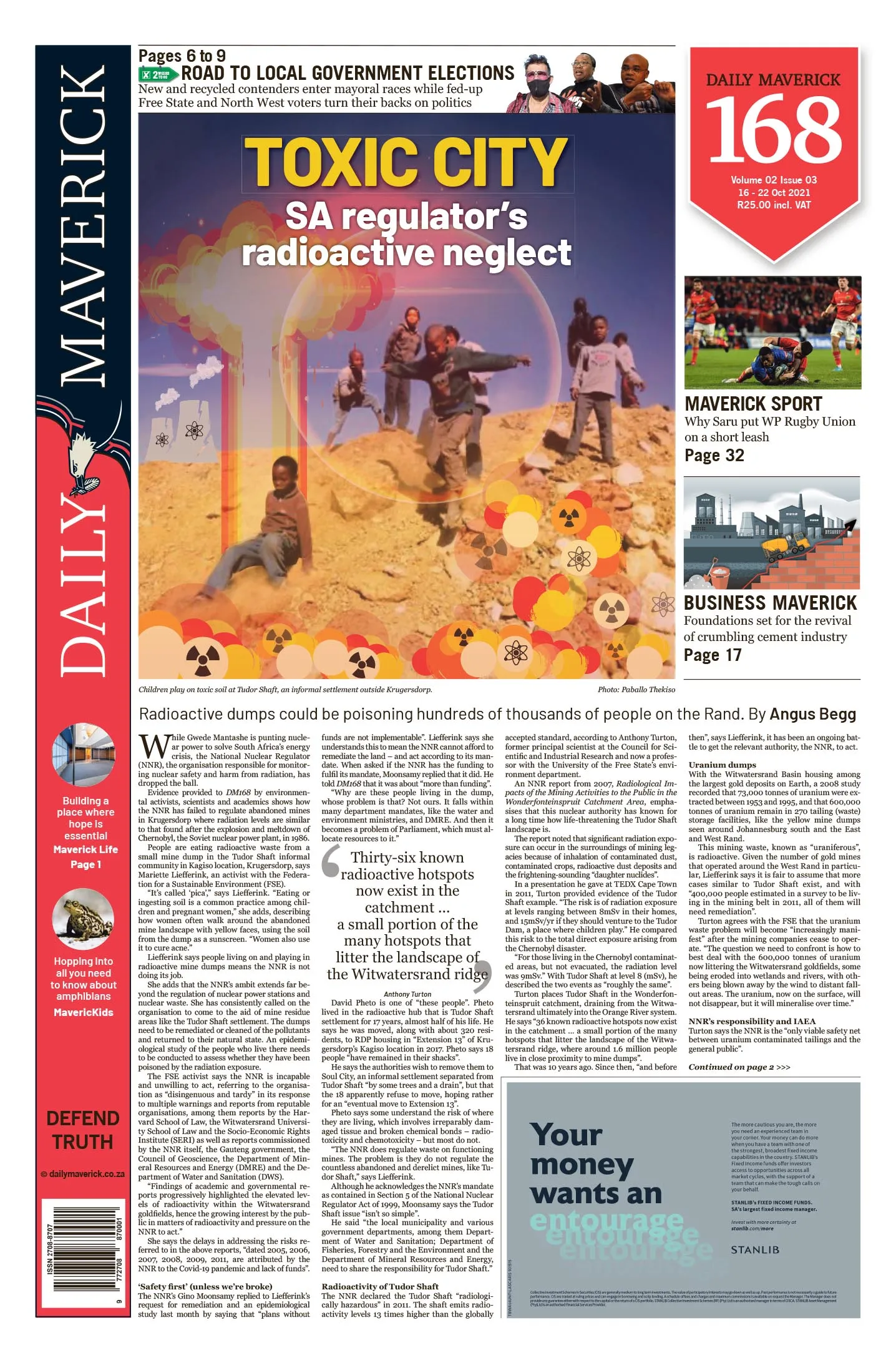TOXIC CITY
SA National Nuclear Regulator neglects radioactive mine dumps threatening the health of thousands

Radioactive dumps could be poisoning hundreds of thousands of people.
While Gwede Mantashe is punting nuclear power to solve South Africa’s energy crisis, the National Nuclear Regulator (NNR), the organisation responsible for monitoring nuclear safety and harm from radiation, has dropped the ball.
Evidence provided to DM168 by environmental activists, scientists and academics shows how the NNR has failed to regulate abandoned mines in Krugersdorp where radiation levels are similar to that found after the explosion and meltdown of Chernobyl, the Soviet nuclear power plant, in 1986.
People are eating radioactive waste from a small mine dump in the Tudor Shaft informal community in Kagiso location, Krugersdorp, says Mariette Liefferink, an activist with the Federation for a Sustainable Environment (FSE).
“It’s called ‘pica’,” says Liefferink. “Eating or ingesting soil is a common practice among children and pregnant women,” she adds, describing how women often walk around the abandoned mine landscape with yellow faces, using the soil from the dump as a sunscreen. “Women also use it to cure acne.”
Liefferink says people living on and playing in radioactive mine dumps means the NNR is not doing its job.
She adds that the NNR’s ambit extends far beyond the regulation of nuclear power stations and nuclear waste. She has consistently called on the organisation to come to the aid of mine residue areas like the Tudor Shaft settlement. The dumps need to be remediated or cleaned of the pollutants and returned to their natural state. An epidemiological study of the people who live there needs to be conducted to assess whether they have been poisoned by the radiation exposure.
The FSE activist says the NNR is incapable and unwilling to act, referring to the organisation as “disingenuous and tardy” in its response to multiple warnings and reports from reputable organisations, among them reports by the Harvard School of Law, the Witwatersrand University School of Law and the Socio-Economic Rights Institute (SERI) as well as reports commissioned by the NNR itself, the Gauteng government, the Council of Geoscience, the Department of Mineral Resources and Energy (DMRE) and the Department of Water and Sanitation (DWS).
“Findings of academic and governmental reports progressively highlighted the elevated levels of radioactivity within the Witwatersrand goldfields, hence the growing interest by the public in matters of radioactivity and pressure on the NNR to act.”
She says the delays in addressing the risks referred to in the above reports, “dated 2005, 2006, 2007, 2008, 2009, 2011, are attributed by the NNR to the Covid-19 pandemic and lack of funds”.
‘Safety first’ (unless we’re broke)
The NNR’s Gino Moonsamy replied to Liefferink’s request for remediation and an epidemiological study last month by saying that “plans without funds are not implementable”. Liefferink says she understands this to mean the NNR cannot afford to remediate the land – and act according to its mandate. When asked if the NNR has the funding to fulfil its mandate, Moonsamy replied that it did. He told DM168 that it was about “more than funding”.
“Why are these people living in the dump, whose problem is that? Not ours. It falls within many department mandates, like the water and environment ministries, and DMRE. And then it becomes a problem of Parliament, which must allocate resources to it.”
David Pheto is one of “these people”. Pheto lived in the radioactive hub that is Tudor Shaft settlement for 17 years, almost half of his life. He says he was moved, along with about 320 residents, to RDP housing in “Extension 13” of Krugersdorp’s Kagiso location in 2017. Pheto says 18 people “have remained in their shacks”.
He says the authorities wish to remove them to Soul City, an informal settlement separated from Tudor Shaft “by some trees and a drain”, but that the 18 apparently refuse to move, hoping rather for an “eventual move to Extension 13”.
Pheto says some understand the risk of where they are living, which involves irreparably damaged tissue and broken chemical bonds – radiotoxicity and chemotoxicity – but most do not.
“The NNR does regulate waste on functioning mines. The problem is they do not regulate the countless abandoned and derelict mines, like Tudor Shaft,” says Liefferink.
Although he acknowledges the NNR’s mandate as contained in Section 5 of the National Nuclear Regulator Act of 1999, Moonsamy says the Tudor Shaft issue “isn’t so simple”.
He said “the local municipality and various government departments, among them the Department of Water and Sanitation; Department of Fisheries, Forestry and the Environment and the Department of Mineral Resources and Energy, need to share the responsibility for Tudor Shaft.”
Radioactivity of Tudor Shaft
The NNR declared the Tudor Shaft “radiologically hazardous” in 2011. The shaft emits radioactivity levels 13 times higher than the globally accepted standard, according to Anthony Turton, former principal scientist at the Council for Scientific and Industrial Research and now a professor with the University of the Free State’s environment department.
An NNR report from 2007, Radiological Impacts of the Mining Activities to the Public in the Wonderfonteinspruit Catchment Area, emphasises that this nuclear authority has known for a long time how life-threatening the Tudor Shaft landscape is.
The report noted that significant radiation exposure can occur in the surroundings of mining legacies because of inhalation of contaminated dust, contaminated crops, radioactive dust deposits and the frightening-sounding “daughter nuclides”.
In a presentation he gave at TEDX Cape Town in 2011, Turton provided evidence of the Tudor Shaft example. “The risk is of radiation exposure at levels ranging between 8mSv in their homes, and 15mSv/yr if they should venture to the Tudor Dam, a place where children play.” He compared this risk to the total direct exposure arising from the Chernobyl disaster.
“For those living in the Chernobyl contaminated areas, but not evacuated, the radiation level was 9mSv.” With Tudor Shaft at level 8 (mSv), he described the two events as “roughly the same”.
Turton places Tudor Shaft in the Wonderfonteinspruit catchment, draining from the Witwatersrand ultimately into the Orange River system. He says “36 known radioactive hotspots now exist in the catchment … a small portion of the many hotspots that litter the landscape of the Witwatersrand ridge, where around 1.6 million people live in close proximity to mine dumps”.
That was 10 years ago. Since then, “and before then”, says Liefferink, it has been an ongoing battle to get the relevant authority, the NNR, to act.
Uranium dumps
With the Witwatersrand Basin housing among the largest gold deposits on Earth, a 2008 study recorded that 73,000 tonnes of uranium were extracted between 1953 and 1995, and that 600,000 tonnes of uranium remain in 270 tailing (waste) storage facilities, like the yellow mine dumps seen around Johannesburg south and the East and West Rand.
This mining waste, known as “uraniferous”, is radioactive. Given the number of gold mines that operated around the West Rand in particular, Liefferink says it is fair to assume that more cases similar to Tudor Shaft exist, and with “400,000 people estimated in a survey to be living in the mining belt in 2011, all of them will need remediation”.
Turton agrees with the FSE that the uranium waste problem will become “increasingly manifest” after the mining companies cease to operate. “The question we need to confront is how to best deal with the 600,000 tonnes of uranium now littering the Witwatersrand goldfields, some being eroded into wetlands and rivers, with others being blown away by the wind to distant fallout areas. The uranium, now on the surface, will not disappear, but it will mineralise over time.”
NNR’s responsibility and IAEA
Turton says the NNR is the “only viable safety net between uranium contaminated tailings and the general public”.
“They [the NNR] will become increasingly significant since tailings dams can no longer be managed by bankrupt gold-mining companies. So, in effect, the risk arising from tailing disposal facilities (TDF) containing uranium have been transferred to the state.”
Handing over responsibility for 600,000 tonnes of uranium to the state (in the form of the NNR) may be questioned by some, when South Africa’s water infrastructure is crumbling, the state struggles to keep the lights on and the traffic lights don’t work.
This is so especially given the apparently obstructive and secretive behaviour of the NNR, the role of which, according to Section 5(a) of the National Nuclear Regulator Act of 1999, is “the protection of people, property and the environment against damage from radioactive sources”.
An example of obstructive behaviour is Liefferink, a former NNR board member, being compelled to use the Protection of Access to Information Act (PAIA) to access information that is in the public interest.
Even the International Atomic Energy Agency (IAEA), the mothership for all member countries’ nuclear activities, questioned the efficacy of the NNR as a safety net.
In a 2013 Mission Report on the Integrated Nuclear Infrastructure Review, the IAEA noted the conflict between the mandate of the Ministry of Energy (now DMRE) – which promotes the use of nuclear power, as Mantashe is openly doing – and the mandate to regulate the industry, by independently granting or denying licences for installations including nuclear power. South Africa’s nuclear regulatory structure is the same as Japan’s was before the Fukushima nuclear plant meltdown in 2011. That structure was found by the Fukushima Nuclear Accident Independent Investigation Commission to be in large part responsible – not the tsunami, as was reported – for the meltdown of the plant.
“The Commission has concluded that the safety of nuclear energy in Japan and the public cannot be assured unless the regulators go through an essential transformation process. The entire organization needs to be transformed, not as a formality but in a substantial way.”
Japan underwent the necessary transformation. Asked for comment, Mantashe referred this reporter to the NNR.
Conflict of interest?
Organisation Undoing Tax Abuse (Outa) energy adviser Liz McDaid, who successfully fought off former president Jacob Zuma’s attempted nuclear dance with Russian President Vladimir Putin in 2017, says she is concerned about the possible conflict of interest at play in South African energy politics, in both the NNR and the National Energy Regulator of South Africa (Nersa).
“President [Cyril] Ramaphosa is talking renewables, while Minerals and Energy Minister Gwede Mantashe sounds like a puppet for the nuclear industry.”
McDaid says she questions Ramaphosa’s stance. “On the one hand he’s talking up renewables, on the other he has signed a performance agreement with Mantashe around nuclear procurement – 2500MW – for which Nersa gave approval (without reasons).”
The Nersa board is appointed by the energy minister, as are the NNR CEO and board. There could be a conflict of interest in the licensing process (all nuclear facilities, whether power stations or mines working with radioactive material, have to pay licence fees).
A peek at the NNR’s 2020 Annual Report reveals that licences issued by the NNR account for R200-million, compared to the government grant of R43-million. This suggests that the NNR is financially dependent on the very bodies it must regulate.
The Krugersdorp dump may be light years away from the nuclear power-station worlds of Koeberg and Fukushima, but with Mantashe courting the coal miners and fast-shrinking nuclear sector – giving the middle finger to the fast-growing renewable energy sector in the process – South Africans need to be reassured that any radioactive business is regulated.
Licensing issues
As an example of the stakes involved in the NNR licence business, the fee to simply apply for the Thyspunt licence, where the government wishes to build a new power station, was more than R19-million (plus expenses).
With Eskom applying for a site licence for a new nuclear plant at Thyspunt in the Eastern Cape, and for a site licence for a new nuclear plant at Koeberg – as well as an extension of the licence for the existing plant, which expires in 2024 – it is now more crucial than ever that the NNR ensures that the best international practice is applied to all safety issues.
Although Eskom has indeed applied to have Koeberg’s lifespan extended, Moonsamy confirmed that permission has not yet been granted by the NNR.
“If the NNR does not have the capacity to manage the waste from the gold-mining industry,” says Liefferink, “how will it have the capacity to manage waste from more nuclear power plants?”
Others are more concerned about how a virtually bankrupt South Africa can afford to have more nuclear power stations built when the world is moving towards renewable energy. DM168
This story first appeared in our weekly Daily Maverick 168 newspaper which is available for R25 at Pick n Pay, Exclusive Books and airport bookstores. For your nearest stockist, please click here.




















 Become an Insider
Become an Insider
The NNR is a compromised entity and is a puppet of the DMRE. I have personally done work for this institute and know how tenders are given to friends of the management of the NNR. Lots of the work is contracted out to organisations that are just a conduit to take money from contracts given to other organisations that actually do the work.
The problem with NNR and ALL your similar institutions (as well as all of ours here in Zambia, and elsewhere in the world) is that they are filled with Political Appointees – who answer to nobody and spend their time fleecing the system (as Raju noted). Imagine if all these boards were elected by the stakeholders and, as public institutions were legally required to make ALL their deliberations and ALL their finances freely available to the public. Only then would we have institutions that actually carried out their mandate – or at least made the public fully aware of (in this case) the problems facing the full decontamination of an area. Bruce Danckwerts CHOMA Zambia